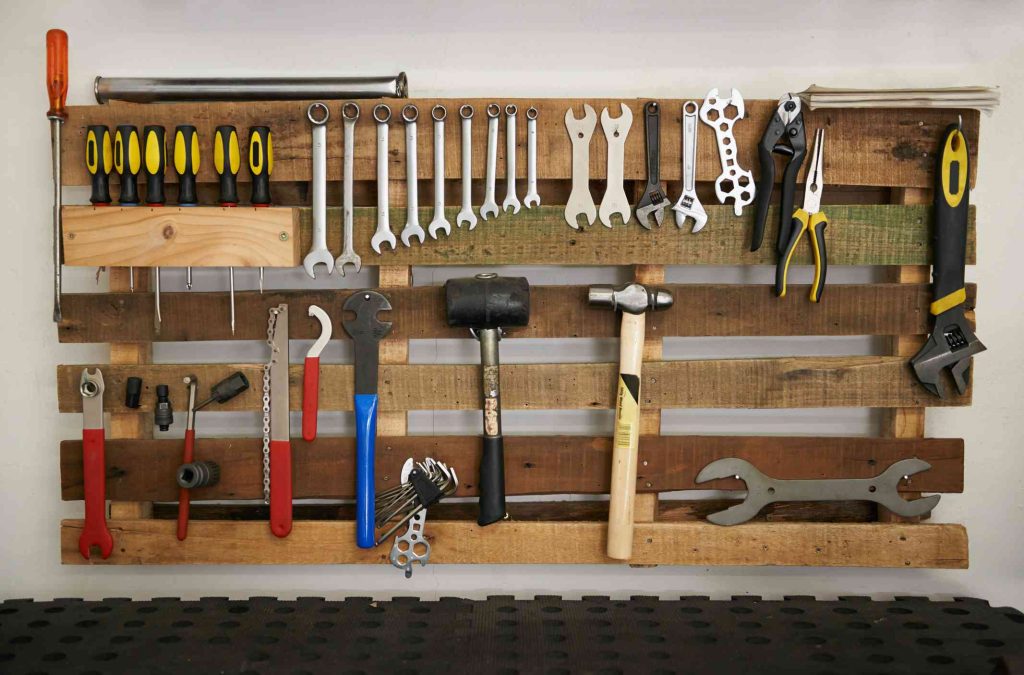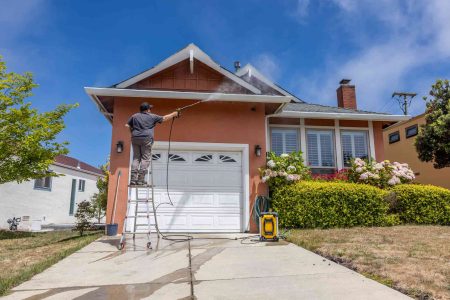From the garage to the workshop to the office and even the living room, there’s no wrong place to install a French cleat wall. This modular storage system is fully customizable, making it the perfect way to add functional storage to a space. Plus, the heavy-duty construction allows for effortless storage of even the heaviest items like tools and books.
However, one of the single best features of a French cleat wall is its ability to dress up or down. While a simple plywood sheet will do the job in a garage or workshop, swapping out plywood for finished solid wood boards will make your French cleat wall a furniture-grade piece that rivals those pricey modular wall shelving units.
What Is a French Cleat Wall?
A French cleat wall is a modular wall storage system that uses a series of boards ripped to feature a 45-degree beveled edge that faces upward, allowing storage devices to securely lock into place via a downward-facing bevel. This mounting method is referred to as a French cleat. The way in which the opposing beveled edges tightly lock into one another allows the modular storage system to support significant weight.
Before You Begin
The most pressing thing to think through before gathering materials for your French cleat wall is what you’d like the end product to look like. While our design will utilize a full 4-foot by 8-foot sheet of 3/4-inch sanded plywood for the wall boards, you could easily swap this out for other 3/4-inch thick solid boards such as pine, poplar, or oak. However, this will increase the overall cost of the French cleat wall, so keep that in mind.
Additionally, you can easily downsize or upsize this design, so feel free to scale it to your specific space. If you do want to use a nice wood such as oak, but the cost increase is too much, consider downsizing the wall system to mitigate the cost increase is a good solution.
Safety Considerations
While the nature of the French cleat’s design allows for secure holding power, the joint is only as strong as that to which it’s attached. Compromising the hold of the wall by failing to screw into the wall studs, overdriving screws, or skimping on materials and construction steps will risk the failure of the entire unit. Pay close attention to all of the steps when constructing the French cleat wall to ensure the safety of those using and interacting around the unit once it’s complete.
What You’ll Need
Equipment / Tools
- Table saw
- Circular saw with cutting guide
- Tape measure
- Pencil
- 4′ level
- Laser level (optional)
- Stud finder
- Drill
- Drill bits
- Countersink bit (optional)
- Sanding block
Materials
French Cleat Wall
- 3/4″ x 4′ x 8′ sanded plywood
- 3″ self-drilling wood screws
French Cleat Wall Accessories
- 3/4″ x 4′ x 8′ sanded plywood
- Wood glue
- Brad nails
Instructions
How to Build a French Cleat Wall
-
Rip Plywood
Rip the plywood board lengthwise to create individual boards with a width of four inches. If you have a track saw or circular saw with a cutting guide, this may be the most effective way to create straight cuts. However, a table saw can also be used, but will likely require assistance at first due to the board’s initial size.
Once finished, if you cut the entire plywood sheet, you’ll be left with 11 4-inch wide boards, as the 12th board will not be a full four inches due to the material removed by the blade. Set the 12th board off to the side for later use.
-
Rip Boards in Half
Using a table saw with the blade set at 45 degrees, cut each 4-inch board in half lengthwise, so that the blade is cutting the board exactly in half. It may take some trial and error. So, first set fence at a point that looks good, then cut just slightly into the board and adjust until the blade cuts perfectly down the center.
Once you’ve figured it out, rip all your boards. If you started with 11, you should end with 22 boards, each with a 45-degree beveled edge on one side.
-
Sand Off Splinters
The downside of plywood is that it often splinters when cut. To remove these splinters, simply use a sanding block. Be careful not to sand too much and alter the shape of the wood.
-
Mark Wall Studs
Once you’ve determined the best placement of your French cleat wall, you need to mark the wall studs. Using a stud finder, mark each stud along the length of your French cleat wall. Use a long level or laser level to translate these marks vertically and lightly trace each stud with a pencil.
Wall studs are typically spaced every 16 inches on center. Taking a screw and driving it into the wall until you feel the screw make contact with the stud is a good way to be certain of the placement.
-
Mount Bottom Board
Start by mounting the first board. Place one end against the stud and screw into place using 3-inch self-drilling wood screws. Place a level against the bottom of the board and adjust until it sits perfectly level. Once leveled, screw the opposite end into place. Check level once more, then continue to screw into each stud.
-
Create Spacers
To make quick work of mounting the remaining boards, create two spacers with the leftover plywood. To make the spacers, cut two 2-inch wide sections from the plywood. Cut one end of each piece at a 45-degree angle, then cut each piece to whatever you prefer the final spacing between the boards to be (at least two to three inches between boards). This way, you can simply stack each board on the spacers and screw it into place.
-
Mount Remaining Boards
Mount the remaining boards by placing the spacers on the highest mounted board, stacking the next board on top of the spacers, and screwing into place. Repeat until all boards are mounted.
How to Make French Cleat Wall Accessories
Making shelves and other accessories to hang on your French cleat wall is as simple as cutting beveled hangers out of your spare plywood or any other 3/4-inch material, then securely mounting them to whatever accessory you can dream up. For a tight hold, always use wood glue in addition to brad nails. To ensure your accessories sit securely against the wall, they should vertically span more than one row of boards.
When to Replace a French Cleat Wall
If properly installed, your French cleat wall should last as long as the wall it’s mounted to. To ensure the safety and effectiveness of your unit, regularly inspect the components on both the wall and the accessories mounted to the wall. If you see any failing joints or components, take time to repair or replace them.
Read the full article here














